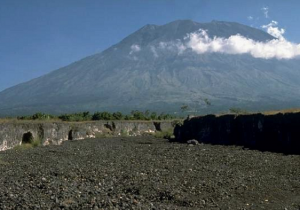
Mount Agung has erupted, impacting aviation in and around Asia and Australia, concerning meteorologists and climatologists too with potential long-term impacts to climate. Some fear the Indonesian volcano can be a “game-changer” when it comes to the Earth’s climate, with a significant eruption leading to a major global cooling episode.
Mount Agung is a composite volcano referred to as a stratovolcano. Stratovolcanoes are characterized by a steep profile and their periodic explosive eruptions. Lava flowing from stratovolcanoes typically cools and hardens before spreading far due to high viscosity, leading to the construction of your typical triangularly shaped volcano compared to the more rounded, sloped volcanoes seen elsewhere in the world such as Hawaii’s Mauna Loa Volvcano.
Volcanic ash can create significant harm to jet engines that fly through them or boat and automobile engines that ingest air-filled air. Volcanic ash is hard and abrasive, and can quickly cause significant wear to various airplane parts such as propellers, turbo-compressor blades, and even cockpit windows. Because volcanic ash particles have a low melting point, it can melt in the combustion chamber of a jet engine, creating a ceramic or glass-like glaze that then sticks to turbine blades, fuel nozzles, and combustors. A jet engine that ingests just a small amount of ash could suffer from total engine failure. Overheating and engine failure is also possible in cars and trucks since volcanic ash can infiltrate nearly every opening in a vehicle. Ash is also very abrasive; ash caught between windshields and wiper blades will scratch and permanently mark the windshield glass, and windows are susceptible to scratching each time they are raised, lowered, and cleaned.
With signs of eruption arriving in late September, authorities evacuated large areas surrounding the volcano. The eruption itself came to life on Saturday evening and at least three times early Sunday, sending ash and steam 13,000 feet into the atmosphere. Disaster officials in Indonesia said that just under a half an inch of ash settled on villages around the volcano; soldiers and police distributed masks to prevent harmful inhalation of the airborne particles. The evacuation zone, which extends 4.5 miles from the crater, remains in place.
The ash clouds have forced the closure of Lombok Island’s airport through Monday morning. Most scheduled domestic and international flights were continuing at Bali’s busy airport, however many airlines have started to suspend service to the area as a result of the drifting ash cloud. Depending on the amount of ash and the direction it spreads in the atmosphere, the airport there and air travel throughout the region could be suspended until the volcanic threat passes.
Beyond the impacts to aviation, the volcano has the potential to disrupt climate and weather around the globe. Past major eruptive events around the world have had significant impacts to weather far away from the volcano itself. After a violent eruption in Indonesia in 1815, winter-like conditions were experienced in the summer in the northeastern United States in 1816. Known as the “year without a summer”, some of the most unusual climatic reports were five consecutive late June nights with frost in Cape May, New Jersey; snow falling on June 7th and 8th in Massachusetts and lake and river ice found in July and August as far south as northwestern Pennsylvania.